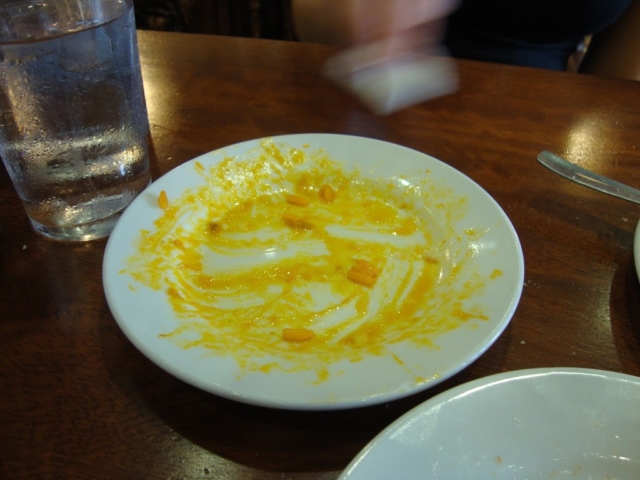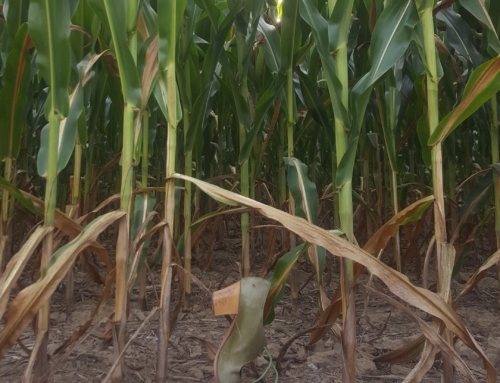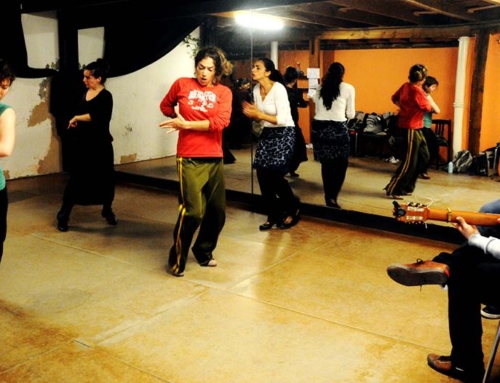…..A lot.
6 Euros gets you into any one of the flamenco peñas. It also gets you a plate of paella big enough for two people at my favorite restaurant–La Bodega in Plaza Alfalfa . Yum! 🙂
 |
| I forgot to take a picture until it was all gone…. |
Earlier this week, 6 euros got me a ticket to see Rosario Toledo’s newest work, ‘Pintoresca,’ and now a question of what is flamenco–can flamenco be deconstructed too far, so much that it is no longer flamenco?
The show is described as follows:
“‘Pintoresca’ de Rosario Toledo refleja no sólo el paralelismo temático con el movimiento pictórico iniciado por Picasso, Braque y Gris, también la búsqueda de nuevos modos expresivos en el flamenco, entre los que se asienta la deconstrucción posmoderna del acontecer artístico. En Pintoresca, la deconstrucción se enfoca hacia la transmutación de la guitarra flamenca, que toca Dani de Morón, y hacia la lectura del baile flamenco como arte total, despojado de la rigidez de pasos, palos y vestimentas al uso” (http://www.diariobahiadecadiz.com/detalle-noticia-24275)
My translation: (Rosario Toledo’s Pintoresco reflects not only a parallel theme with pictorial movement initiated by Picasso, Braque and Gris, but also the search for new modes of expression in flamenco, in which postmodern deconstruction is set up by the artistic occurrence. In Pintoresca, the deconstruction focuses towards the transmutation of the flamenco guitar, played by Dani de Morón and towards the reading of flamenco dance as a total art, stripped of the use of the rigidity of steps, rhythms and costumes. )
In many ways Toledo’s style of dancing in general is similar to that of the cubist artists of the 20th century. The lines she makes with her body are geometrical interpretations of more ‘academic’ flamenco lines and postures. Toledo builds phrases in a sort of piecemeal manner, beginning with short phrases, then deconstructing them and adding in fillers to create longer phrases, or she mixes and matches phrases and using repetition creates whole choreographies. In other words, she can take a short phrase and look at it from many angles to create a complete choreography–similar to the cubists that looked at an object from multiple angles.
I loved the concept of the show, and the final scene which brought together projections of the images, Toledo’s dancing, and a representation of Picasso’s cubist guitars was visually astounding. However, the show never gave me moments to latch on to; the beginning with Toledo in a box dragged on for too long and was a bit to obvious as to its representation of breaking out of a box. The dancing combined with the drawing of a cubist drawing on a large black panel lacked dynamic. Toledo re-used tropes from previous works–for example that of ‘discovering’ her flamenco shoes. Maybe the problem is trying to represent a two dimensional object in time in space–is it possible? Or to represent sound in a two dimensional object? As for whether or not it is flamenco or just dance; Rosario is trained and labels herself as a flamenco dancer, but when you take away the traditional aesthetics, the traditional structure, and the cante, there’s not a lot that makes it flamenco. Which is not to devalue the show; as a work of dance it’s superb. Maybe if I had gone into it expecting dance and not flamenco, I wouldn’t feel like it was missing something. At the least it’s given me lots to think about….And speaking of dance:
In the States: 6 euros, or the 8 or so dollar equivalent doesn’t get you much in New York. A bagel with lox, not bad I guess…For a little more, I can see some of the best dance companies in the world; I am so looking forward to New York’s Fall for Dance Festival. The tickets are a little more than 6 euros, but not much; $15.00 gets you a ticket to any of the shows. Here’s the link with more info:
http://www.nycitycenter.org/tickets/productionNew.aspx?performanceNumber=7520





Alice, I love your blog- my husband and I are coming to Sevilla for three months later this year, and reading your posts has made me so excited for our trip. I hope you continue to have exciting adventures!
Alice Rosario images